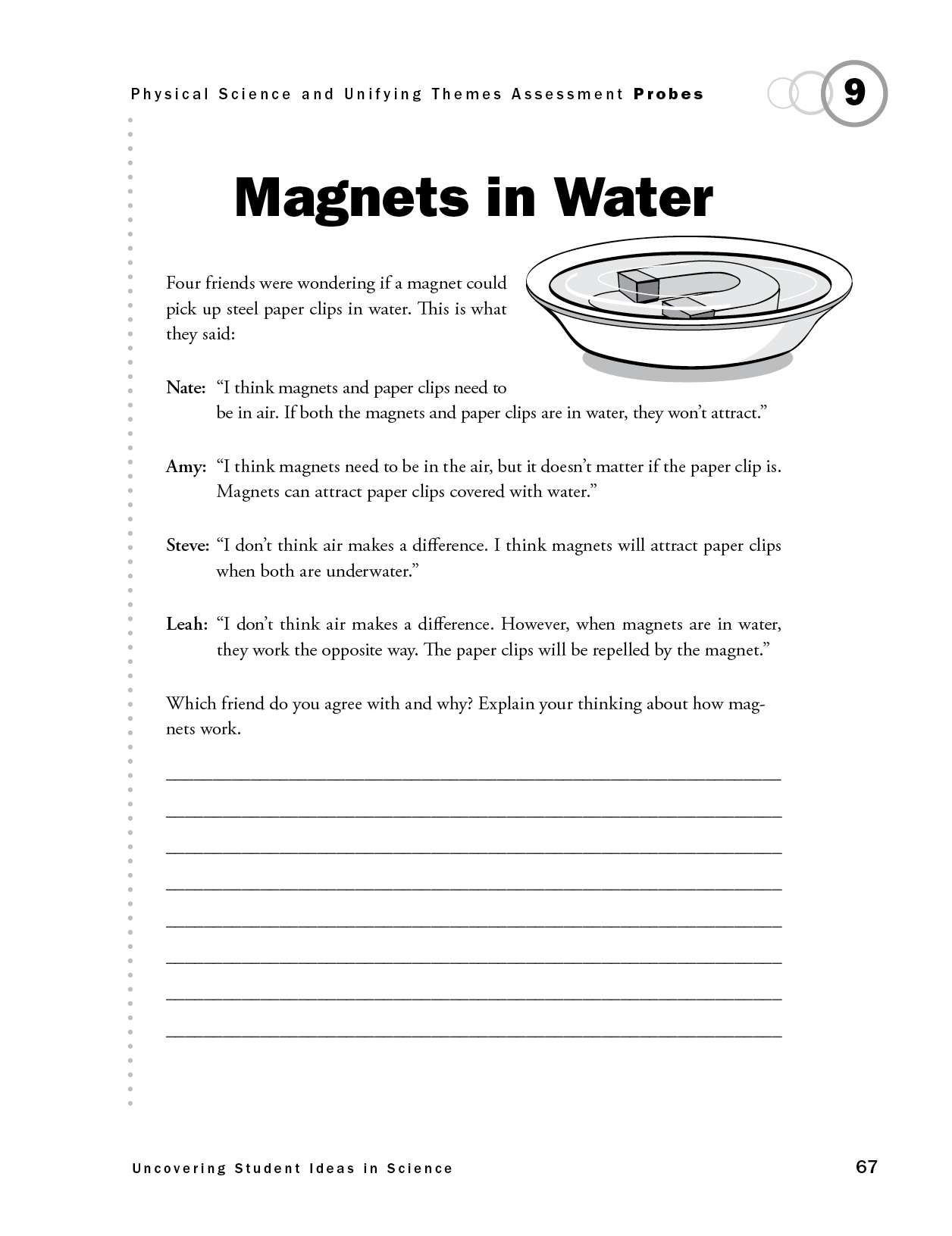Elementary | Formative Assessment Probe
Magnets in Water
By Page Keeley
Assessment Physical Science Elementary Grade 3
Sensemaking Checklist




This is the new updated edition of the first book in the bestselling Uncovering Student Ideas in Science series. Like the first edition of volume 1, this book helps pinpoint what your students know (or think they know) so you can monitor their learning and adjust your teaching accordingly. Loaded with classroom-friendly features you can use immediately, the book includes 25 “probes”—brief, easily administered formative assessments designed to understand your students’ thinking about 60 core science concepts.

Purpose
The purpose of this assessment probe is to elicit students’ ideas about magnetism. The probe is specifically designed to determine whether students believe air is necessary for magnets to work.
Type of Probe
Friendly Talk
Related Concepts
magnetism
Explanation
The best answer is Steve’s: “I don’t think air makes a difference. I think magnets will attract paper clips when both are underwater.” Magnetism is a force that can work through a gas, a liquid, and even a solid (e.g., nonmagnetic materials such as paper, wood, aluminum foil, tape, and plastic). Just as electricity moves through some materials better than others, magnetism moves with ease through some materials and has more difficulty passing through other materials. Although most peoples’ experiences with magnets happen in an environment in which the magnet is surrounded by air, magnets also work underwater and in other gaseous environments, such as in carbon dioxide and helium. Magnets also work in environments without an atmosphere or air. For example, a magnet on the Moon or a magnet in a bell jar with all the air removed will attract iron objects.
Curricular and Instructional Considerations
Elementary Students
In the elementary grades, magnets provide students with multiple opportunities to engage in inquiry while developing the idea that forces can act without directly touching an object. Students’ experiences with magnets are mostly observational. Explaining the specifics of how magnets work should wait until students develop a deeper understanding of forces in middle school.
Middle School Students
In the middle grades, students combine their knowledge of magnets with their understanding of electric current. At this level, students have developed ideas about gravity and electric charge that may interfere with ideas about magnetism.
High School Students
At the high school level, students develop more sophisticated ideas about electromagnetism. However, early misconceptions related to magnets and their effect in air may still persist.
Administering the Probe
This probe is appropriate at all grade levels. You might consider using a prop by first showing how magnets pick up paper clips when both are in air and then putting a magnet in water and asking students what they think would happen if the paper clips were placed near the magnet. This probe can lead to a lively discussion of students’ ideas.
Related Research
- Research has shown that some students are inclined to link gravity with magnetism (Driver et al. 1994). If they believe gravity is necessary for magnets to work and also believe that gravity has no or less of an effect under water, they may believe magnets will not attract objects in water.
- Barrow (1987) investigated students’ awareness of magnets and magnetism across age ranges and found that they were aware of magnets through their everyday experiences of sticking objects to refrigerators with magnets. However, before instruction, few students could offer explanations of magnetism, especially in terms of forces and how magnets work (Driver et al. 1994).
- Bar and Zinn (1989) sampled 98 students ages 9–14 and found that 40% believed that a medium (air) was necessary in order for magnets to have an effect on objects. Twenty percent of these students also made a link between gravity and magnetism (Driver et al. 1994).
Related NSTA Resources
American Association for the Advancement of Science (AAAS). 2007. Atlas of science literacy. Vol. 2. (See “Electricity and Magnetism” map, pp. 26–27.) Washington, DC: AAAS.
Ansberry, K., and E. Morgan. 2007. More pictureperfect science lessons: Using children’s books to guide inquiry, K–4. (See “That Magnetic Dog,” pp. 123–129.) Arlington, VA: NSTA Press.
Kur, J., and M. Heitzman. 2008. Attracting student wonderings. Science & Children (Jan.): 28–32.
Robertson, W. 2005. Electricity and magnetism: Stop faking it! Finally understanding science so you can teach it. Arlington, VA: NSTA Press.
Suggestions for Instruction and Assessment
- This probe can be used with the P-E-O (Predict, Explain, Observe) strategy (Keeley 2008). Have students make a prediction, explain the reasons for their prediction, and test their ideas. If their observations do not match their predictions, challenge them to construct a new explanation to fit their observations.
- Consider probing students’ ideas about magnets related to their ideas about gravity. Do students believe gravity is necessary in order for magnets to work? Do they link the idea that air is necessary for gravity and thus link magnetism to gravity as well?
- Barrow’s (1987) study considered that teaching about magnets might dissociate students from their everyday awareness of magnetism. Barrow suggested that teaching approaches that draw on everyday experience and focus on uses of magnets may be effective in helping students understand magnetism.
- Providing opportunities for students to test and observe how magnetism passes through solid materials such as paper, plastic, and aluminum foil may help support the notion that magnetism also passes through a liquid such as water.
- Challenge students to think about whether magnets work in the absence of air and come up with a way to test it. One way is to suspend a magnet attracted to a paper clip in a bell jar. If students think air is needed in order for the paper clip to remain attracted to the magnet, have them observe whether the paper clip will drop.


